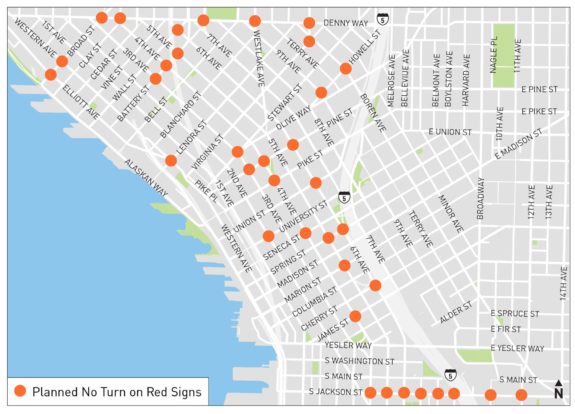
All new or upgraded traffic signals in Seattle will feature “No Turn On Red” restrictions by default while also retrofitting dozens of existing signals with the signs. So even though a turn on red ban did not make it through the Washington legislature this year, Seattle is not waiting for the state. In fact, perhaps Seattle’s experience will help create more momentum for a turn on red ban in the next session.
The SDOT memo (PDF) announcing the department’s new policy notes a couple very troubling facts:
Until 1959 the City of Seattle prohibited right turns on red. In 1975, the federal Energy Policy and Conservation Act (EPCA) required all states to permit right turns on red to reduce fuel consumption and estimated a travel time savings of 1–5 seconds for vehicles turning at signals. Studies following the 1975 EPCA showed that right turn on red crashes with people walking increased by 60 to 70 percent.
— Advertisement —
There are times when the total disregard for basic ethics by the traffic engineering profession is truly astounding, and this is one of them. There is no amount of time savings for people driving cars that would ever be worth increasing right turn on red crashes with people walking by 60 to 70 percent. Yet U.S. federal policy essentially required all states to permit turns on red in the 1970s, and Washington was at the forefront of that movement. It shouldn’t require stating, but people’s lives are more important than drivers maybe saving a few seconds. Like, we all agree on that, right?
Seattle has found that 9% of all collisions at signalized intersections that involve people walking are due to turns on red, turns that would be illegal in most of the world and were illegal in Seattle until 1959. A recent study by the Institute for Transportation Engineers notes that installing “No Turn On Red” reduced instances of people driving failing to yield to pedestrians by 92% during the red interval. The same study found “minimal increase in waiting for vehicle traffic,” according to the SDOT Blog.
But this is not just about pedestrians. The signs also reduced drivers’ conflicts with other cars by 97%. It turns out, watching for gaps in traffic and then gunning it through a red light and two crosswalks while simultaneously merging is really dangerous. Like, sure, it’s not a big deal most of the time. But there are so many opportunities for something to go wrong. Drivers cannot possibly be looking at all potential points of conflict at the same time. The most obvious example of this happens when a person enters a crosswalk and has the walk signal at the same time that the person driving the nearby car is looking to the left for a break in traffic so they can turn right. If they start moving forward without first looking right again, they might hit the person directly in front of them. But if they look right to check that the crosswalk is clear, they have taken their eyes off the gap in traffic. All this is frankly too much to ask of the driving public.
The new policy does have lots of potential loopholes, as most of these SDOT policies do. So it remains to be seen how it will be implemented in the real world. But undoing turns on red is a policy that is long overdue.








Comments
5 responses to “‘No Turn On Red’ is now the default for new or upgraded Seattle traffic signals”
I’m pleased SDOT is taking this action to improve safety.
There is another approach to increase crosswalk safety, which never seems to come up in Seattle, though it is prevalent in France and probably other countries.
This alternate solution is to separate the the crosswalk from the intersection. Put the crosswalk about 1 car length back from the intersection and put the stop line there, too. So, at a red light, traffic stops before the crosswalk, about 1 car length from the intersection.
Then, if a right-on-red is allowed, a driver would look only at the crosswalk before proceeding to the intersection. Once at the intersection, the driver need only look left for oncoming traffic to make the right turn. No peds allowed in that area (and a fence could enclose the whole corner to help ensure that).
Another benefit of this is allowing more lanes through the actual intersection – no curb bulbs or other narrowing at the actual intersection, meaning more traffic would flow through during each signal.
I’m not sure how this design would affect bikes. I need to think through that or draw a picture…
For peds, this would be much, much safer than our existing right on red. The tradeoff is that peds would need to make a 2 car length detour to cross the street. Is that a good tradeoff?
I doubt it would work. Take a look around next time you’re at an intersection: many drivers already stop ahead of the stop line and even in the crosswalk. Moving the line back further would only make a difference to the most attentive drivers; the majority would just continue their bad habits.
Same goes for the no right on red signs; most drivers still ignore them. Without an incentive to change, people won’t.
Well, even if they don’t stop at the stop line, it still separates the peds from the right turns. The crosswalk moves back about 20′ from the intersection. So, a driver need only be aware of one thing at at time. This would be a huge safety improvement.
It doesn’t stop them any differently. They already roll in to the crosswalk on a red
I have been hit by automobiles 4 times while riding my bicycle over the last 45 years. 3 times I was hit by cars (and one school bus) that were making right hand turns through red lights.
It is about time for a change in our laws.